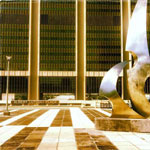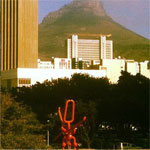
The tour started at Truth Coffee where owner David Donde (@DavidDonde) has arguably done a lot to cheer up the East City precinct with Haldane Martin's (@HaldaneMartin) spectacular refurbishment of a previously sad, old Buitenkant Street shop front, now up for no less than a coveted World Restaurant & Bar Design award.
Christo Moritz of Infestation Design (@DznInfestation), which has done a great job of the communications collateral for Open Design CT, stated the objective of the event as being "to demystify design" and "to get rid of the silos in design disciplines," observing that, "Cape Town is a city of creators and innovators, who have never been exposed." Some of the reasons for this may be revealed via this article.
After a complimentary coffee and welcome address by Zahira Asmal (@ZahiraAsmal), director of Designing_South Africa (@Designing_ZA), an outfit which was "set up and funded as an archive of the urban and design impact of the FIFA 2010 World Cup." With these credentials, Zahira seems well-positioned to achieve her objectives of, "bringing people together in the public space," and for, "designers to stop saying where's the brief, but to take the briefs to government."

With these lofty ambitions, our band of media head downtown to pause in the shade of some non-indigenous pines at the South Easterly corner of the Grand Parade's grey hydro-paved surface and listen to an address by Open City architect and designer, Bettina Andrag (@Bandrag). Apart from having a degree from the London School of Economics and publishing a book called Cape Town Stadium, Between the Lines - which I can't wait to read - Andrag has also written a paper on, "The Value of the Grand Parade for the Informal Trader." Ironic as it might be to hear the parade referred to as "a trading space," having had its traders systematically "redistributed" in the pre-2010 World Cup clean-up, Andrag has undertaken a comprehensive study into how the city leases its land to the 1000s of traders, from 11 different African countries, 80% of who are not South African and fall under the umbrella of six different trader organisations. She tells of the young Tanzanian refugees who act as "couriers" for goods and a host of other handy information about how it is that mostly Chinese imports come to be available for sale to the 160,000 or so commuters who daily traverse this public space, where among other historic events, Nelson Mandela made his first public address in 1990.
Khalied Jacobs from Jakupa Architects and Urban Planners (@Jakupa) stepped up to the plate to inform us of the parade's relationship with "security" and previous "militarisation of its space." Apparently, in the early days of the colony, a cannon was fired and wherever the canonballs landed was demarcated a "no-go zone." That might be what inspired the rows of concrete aggregate balls which, apart from Edward VII and the monument to the unknown warrior, make up the parade's sole décor. Watching a lone trader, bathed in watery winter sunlight, push his trolley across the 5000m2 expanse of paving, I can safely share with you the fact that 300 years later, it is still not exactly a wow destination.
Shortly after, we were following in the trader's tracks over the Strand Street pedestrian bridge to the top of the Cape Town Station deck, which has been renovated to include functional lock-up-and-go trading vehicles. These souped-up containers include locks, lighting and awnings - all in a non-offensive white gloss enamel finish. The area is clean, the backdrop of Table Mountain breathtaking. I wondered if any tourists or locals who do not need to catch the train, even know about it. In any case, I was glad to have stumbled on a nice new shopping precinct for clothing, shoes, leather goods and hair extensions, and will definitely visit there again.

Snapping photos and trying to stay with our group, we wandered down the stairs that lead into the "new" Cape Town Station. Also dollied up for WC2010, and seeing as we were there in the name of design, the station was noticeably devoid of any kind of public art or decoration that might have added a moment of joy or emotion to its geometry. Could this be the world's most under-decorated public transport hub? No wonder none of our citizens are aware of the wonders of our design skills. It becomes obvious that between World Cup 2010 and World Design Capital 2014, our designers have simply not been commissioned.
As we emerge on the other side of another 3000 square metres of empty paving waiting for its next "public event to happen," and ponder the possible range of activities that might occur on its tabula rasa - someone suggests bringing back the informal traders... In pursuit of repurposing ideas that bring more people together in the public space, there are lots of solutions. More retail outlets for Chinese wholesalers, if it is even one, is far from the only one. Designers dig deep.
From there we were escorted to Prestwich Square Memorial where a sister branch of Truth Coffee doubles as an ossiary and museumlet for the ancestral remains of slaves found at the Green Point burial ground during the excavations of the Green Point Stadium for 2010 World Cup. The bones themselves are not on display per se. Nick Shepherd who is Professor of African Studies at UCT, tells us they are in a cardboard box and the monument is more about forgetting rather than remembering, but there are some nice display boards, which you have to crawl through a little tunnel to reach. If you are interested, I found quite a nice article about it at www.archivalplatform.org.
We remarked at the contrast between the profundity of where we are sitting and Heath Nash's "It's beautiful here" rainbow art that we saw through the glass doors across the square...
Here we also met Jay Pather, choreographer and academic, who is the convener of the popular Infecting the City event. During the above presentations terms like Palimsest, post-structuralist, interstitial, metamorphic and disconnectedness are lobbed into the conversation, which at this stage pretty much sums up our approach to public art. It is fine when it is not permanent, a performance here, an installation there, and gone tomorrow...
En route to our penultimate stop, the architectural practice of Heinrich Wolff, we briefly stop at the Bree Street studio of Heather Moore's Skinny la Minx (@skinnylaminx) phenomenon. Moore has degrees in Illustration and Education from UCT. Her talent is prodigious and she has built a mini-empire. She is great example of the inherent power of design and motif to create economies out of nothing.
One of our guides for the day Ilse Wolff (@OHA_tours) introduced us to her life and business partner architect Heinrich Wolff (@Wolff52). We were invited to gather round the boardroom table in their Bo Kaap studio to hear an inspiring presentation. A flagship project for World Design Capital 2014 will be Wolff's ambitious plan for the repurposing the V&A Waterfront's old Blue Shed precinct into new premises for the UCT Business School. The stroke of genius is in building the Business School above the market, so that the students can look down upon the nitty gritty of our market economy and the marketeers can no doubt see up, allowing for a potentially fascinating cross pollination of sustainable economic models. All we need to do is throw some designers into the mix and voila, free market economies are us!

We conclude our journey at the City Hall where, for another week under the waving flags of Infestation Design's lumo orange banners, there are daily lectures, design classes, displays by all the city's tertiary design institutions, the Mandela 100 posters initiative on display to schools and public, coffee lounges, restaurants and bars.
Lastly, we were introduced to the curator of the whole expo, Tsai, who talked us through some of the amazing examples of ZA design that visitors have the opportunity to see in the space and why they were selected.
I am looking so forward to debates that will turn dysfunctional public spaces into multi-functional ones - from Future Cape Town's Open City Mini-Con [report following] to Designing_SA's big daddies at the Designing our Democracy conference later in the week and all the other sessions and demonstrations that will put civic design squarely on our agendas.
Designers need no longer be hamstrung by the shadows of legacy. Designing for play, for work, for leisure, for showcasing our art and our streets as inspirational and aspirational destinations for all our citizens and communicating that we are not just one giant flea market, now that will be a legacy. There are myriad ways to get involved with regard to the design you want to see in Cape Town, so use the channels to make sure your voice is heard.
Read A sense of belonging - bite-size lessons from the Big Apple.
For more info on Open Design Cape Town, go to www.opendesignct.com.
